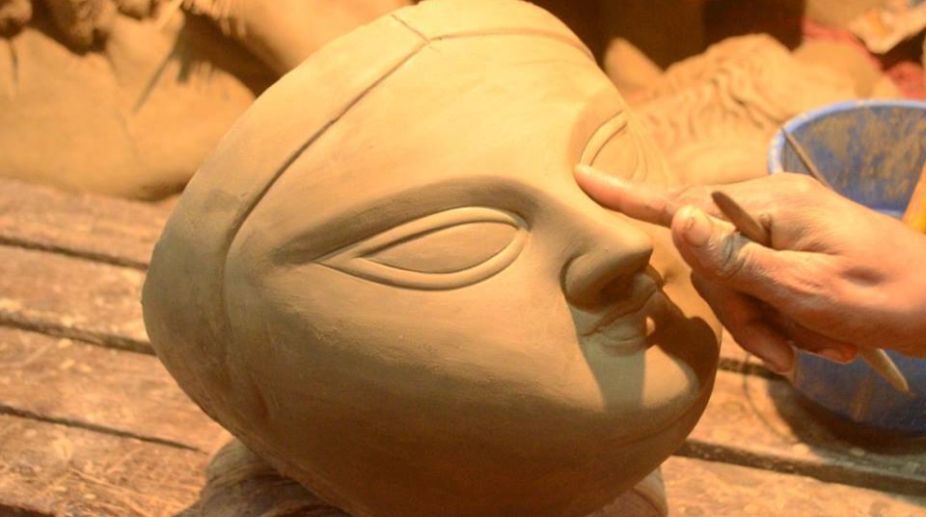Kumortuli – in North Kolkata (formerly Calcutta) beside the Hooghly River, is the most popular centre of clay creativity. While the British colonisation of Bengal and India started following the victory of the British East India Company in the Battle of Plassey (1757), the villages of Gobindapur, Sutanuti and Kalikata merged and formed Calcutta.
Lord Holwell, as per the Company’s orders, allotted separate districts to the workmen and divided the areas by occupation and named them – Suriparah (place of wine-sellers), Collootolah (place for oil men), Coomartolly, now Kumortuli (potter’s quarters) and so on.
The life-like structures of the clay deities are gifted with life from the day they have been started making. The process starts with the skeleton made of seasoned bamboos, followed by a base of clay mixed with straw and applied over the framework. This is heated to harden as much as any clay pot would be set.
Advertisement
Aside, a part of clay is prepared to be put in moulds and get the structure of the face done with intense love and care. The hands and other body parts are done hereby; covered with pieces of plain cloth and put to dry.
Then a white colour base coat is applied. A second coat gets applied once the previous is partially dry, thereby applying the desired shades to be used.
The drawing of the eye needs to be too patiently handled and as if the painter is donating his own eyes – chokkhudaan (donating one’s eyes) – the first time the idols come to life.
Last but not the least, the idol is then dressed and completed with finishing touches and the ornaments and other accessories are fixed.
The sweet scent of Puja is already in the air and is stimulating our hearts. But what do the artisans, who work day in and day out during this time, have to say?
Artisan Subhash Pal commented that their main concern is to finish the work rather than enjoy the Puja gleefully. They hardly get time to go out with their family to enjoy the Puja.
Artisan, Naba Pal says, “After Durga Puja gets over, I always look forward to the puja of the next year since every year brings to us new challenge, new opportunity to compete in the making of the Durga Pratima.” Moreover, the number of Durga idol production has even increased over the years with the increase in the residential areas and increase in the number of puja pandals.
Idols of Kumortuli have managed to strike a chord deep in the hearts of people all over the world. Straws come from all over Bengal, bamboo come floating through the waters of Hooghly, ‘bele maati’ is collected again from the Hooghly river whereas ‘etel maati’ comes from Uluberia and Diamond Harbour.
Colours are taken from the nearby Burrabazar area. These are then distributed to individual workshops. The artisans collect them all under a single roof and then proceed towards the making of the idols. The average cost of an idol varies from thousand to lakhs.
After the completion, the idols of Kumortuli are sent tot all over Kolkata, in other regions of India and even abroad, like, Spain, Japan, Russia, France, London and so on. The idols which are exported are made of fibre-glass and have an average height of about five feet.
They are exported around the month of April via ship and also by flight. Over the years, hurdles and problems have arisen and even ebbed away. But presently, several crucial problems seem to trouble our beloved artisans. According to artisan Indrajit Pal, the GST and demonetisation issues have created a great lot of problems.
The effect on the raw materials has increased their cost to a considerable extent. But, on the other hand, the cost of the Durga idols cannot be increased proportionally. This has forced the artisans to make little profits and has added hardships.
Debabrata Pal, Secretary of Potters’ Organisation, stated the lack of cheap labour and even the availability of labourers are gradually becoming areas of grave concern.
The artisans also stated that the bank loans which were easily provided to them previously, have gone beyond their reach; the reason which could be conjectured might partly be for their inability to repay the loans and partly due to the effects of GST.
It has been a collective view of the artisans that the future of their business and craftsmanship is uncertain. The future progeny of majority of the artisans are well-educated and are excelling in different walks of life. They plan to take up careers of their choice unlike their father and forefathers. The majority of the artisans are continuing this legacy for fourth or fifth generations; but fortunately or unfortunately, their children are not interested in this age-old business.
Though the future of this form of art seems dismal, yet the positive feeling which the Puja itself brings in, seems to wash away all our doubts and apprehensions.
(Adrija Dutta, Coordinator, Class XI, Sneha Roy, Coordinator, Class XI, Anshu Nandi, Class IX, Rikishi Majumdar IX, St Joseph & Mary’s School)
Advertisement











